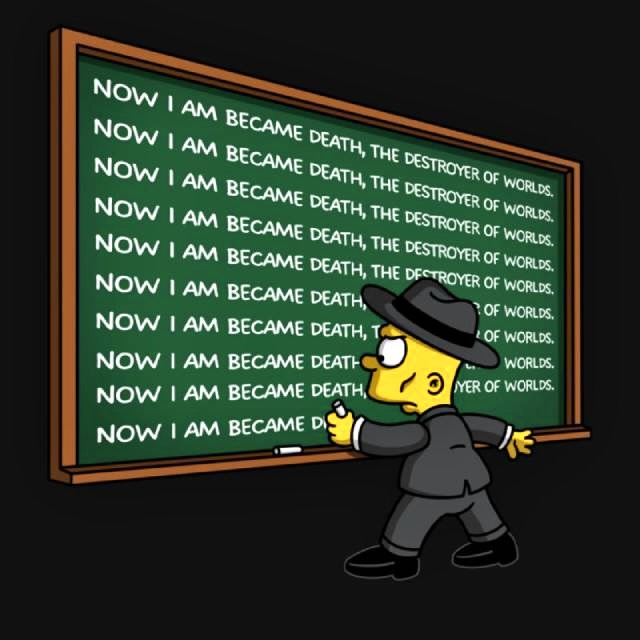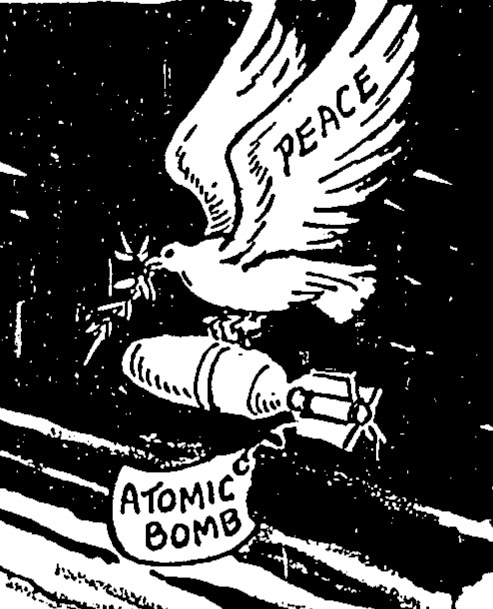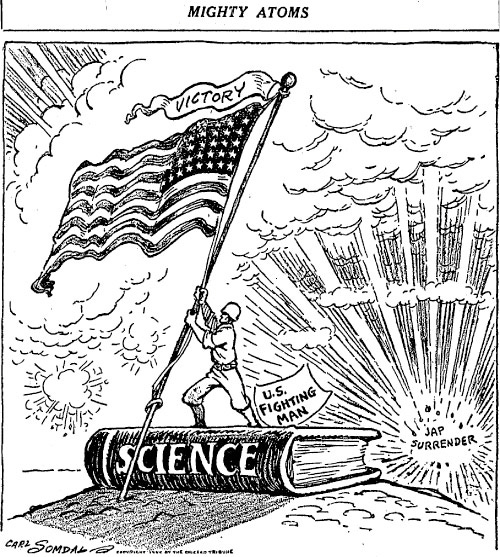Reprinted with permission from Greg Mitchell’s newsletter Oppenheimer: From Hiroshima to Hollywood.

Before “Barbieheimer” there was… “Bartenheimer.”
With the need to focus on run-up to August 6 and aftermath of Hiroshima bombing, I’ve had less on the Oppenheimer film lately, though frankly there might not be much more to report or observe. I’ve covered a lot of ground in the past 24 days, since this has been a daily endeavor. But a few notes:
– The movie has now topped Saving Private Ryan as most boffo at box office among all “World War II” films, as they classify it. And now it’s been extended at IMAX theaters….As for DVDs and streaming later: Cillian Murphy says the movie has no “deleted scenes”….A paperback version of Nolan’s screenplay sold out quickly (I know, I tried to order) and is now is on back order. And there is no ebook version right now…
– Thanks to Nolan film, lot of attention on new doc (in theaters and streaming) about “the other spy” (besides Klaus Fuchs, who is featured in Oppenheimer), Ted Hall, the youngest of all the scientists at Los Alamos, who was IDed but somehow never arrested. I watched and it’s quite interesting, if overlong, even if you don’t buy his claim that he leaked to the Soviets simply to produce a kind of balance-of-destruction.
– Fun comment by friend Michael Goldfarb: “Gary Oldman adds Truman to his Churchill. If he plays Stalin next, Peter Morgan could write him a one-man show called Potsdam with Gary playing all three.” Also: “Florence Pugh definite winner of Best Supporting Actress Who Wears Clothes for Less Than 20 % of Her Screen Time.”
– More and more local media outlets have reported on effects of fallout from the Trinity test (ignored in the movie) and nuclear tests and worker radiation exposure later. Here’s the tale of one Oak Ridge worker. I could go on.
– Our friends at the always vital National Security Archive had a major release and story yesterday, after a Freedom of Information requested yielded docs that prove even further (as I’ve long written) that scientists and others knew what the radiation effects would be after a bomb drop. Now this is confirmed again in formerly classified studies by U.S. experts here and in Japan, and yet Gen. Groves and others lied about it for months. Oppenheimer? He said little but let it pass, and then took part in the propaganda press junket to the Trinity site.

President Truman’s announcement to the nation on August 6, 1945 – in which he carefully identified Hiroshima only as a “military base,” not a large city – broke the news of both the invention of an atomic bomb and its first use in war, as I explored here two days ago. By that evening, radio commentators were weighing in with observations that often transcended Truman’s announcement, suggesting that the public imagination was outrunning the official story. Contrasting emotions of gratification and anxiety had already emerged. H.V. Kaltenhorn warned, “We must assume that with the passage of only a little time, an improved form of the new weapon we use today can be turned against us.”
It wasn’t until the following morning, Aug. 7, that the government’s press offensive appeared, with the first detailed account of the making of the atomic bomb, and the Hiroshima mission. Nearly every U.S. newspaper carried all or parts of 14 separate press releases distributed by the Pentagon several hours after the president’s announcement. They carried headlines such as: “Atom Bombs Made in 3 Hidden Cities” and “New Age Ushered.”
Many of them written by one man: W.L. Laurence, a Pulitzer Prize-winning reporter for the New York Times, “embedded” with the atomic project. General Leslie Groves, military director of the Manhattan Project, would later reflect, with satisfaction, that “most newspapers published our releases in their entirety. This is one of the few times since government releases have become so common that this has been done.”
The Truman announcement of the atomic bombing on Aug. 6, 1945, and the flood of material from the War Department, firmly established the official nuclear narrative, which endures to this day. It would not take long, however, for breaks in the official story to appear.
At first, journalists had to follow where the Pentagon led. Wartime censorship remained in effect, and there was no way any reporter could reach Hiroshima for a look around.

On Aug. 7, military officials confirmed that Hiroshima had been devastated: at least 60% of the city wiped off the map. They offered no casualty estimates, emphasizing instead that the obliterated area housed major industrial targets. (In fact, 80% of the casualties would be civilians, mainly women and children.) The Air Force provided the newspapers with an aerial photograph of Hiroshima. Significant targets were identified by name. For anyone paying close attention there was something troubling about this picture. Of the 30 targets, only four were specifically military in nature. “Industrial” sites consisted of three textile mills. (Indeed, a U.S. survey of the damage, not released to the press, found that residential areas bore the brunt of the bomb, with less than 10% of the city’s manufacturing, transportation, and storage facilities damaged.)
On Guam, weaponeer William S. Parsons and Enola Gay pilot Paul Tibbets calmly answered reporters’ questions, limiting their remarks to what they had observed after the bomb exploded. Asked how he felt about the people down below at the time of detonation, Parsons said that he experienced only relief that the bomb had worked and might be “worth so much in terms of shortening the war.”
Almost without exception newspaper editorials endorsed the use of the bomb against Japan. Many of them sounded the theme of revenge (for Pearl Harbor) first raised in the Truman announcement. Most of them emphasized that using the bomb was merely the logical culmination of war. “However much we deplore the necessity,” the Washington Post observed, “a struggle to the death commits all combatants to inflicting a maximum amount of destruction on the enemy within the shortest span of time.” The Post added that it was “unreservedly glad that science put this new weapon at our disposal before the end of the war.”
Referring to American leaders, the Chicago Tribune commented: “Being merciless, they were merciful.” A drawing in the same newspaper pictured a dove of peace flying over Japan, an atomic bomb in its beak. Meanwhile, the unthinking atomic assembly line had rolled out another bomb, targeted on Kokura with Nagasaki as backup. No separate order was required or given by Truman.

The deaths have been known for awhile but the reports still shock most people. Few Americans know that among the tens of thousands victims in Hiroshima were at least a dozen and perhaps more American prisoners of war. They came from three bombers that had been shot down.
This was kept from the American people – even the families of the victims – for decades, along with so much else related to the atomic bombings.
One night, as a pair screamed in pain in their cells – asking to be put out of their misery – the other Americans asked the Japanese doctors to do something. “Do something?” one of the doctors replied. “You tell me what to do. You caused this.” The two men died later that night.
Three days after the Hiroshima blast, perhaps as many as a dozen Dutch POWs were killed in the bombing of Nagasaki. One American soldier there, a Navajo from New Mexico, survived in his cell.
Greg Mitchell is the author of a dozen books, including “Hiroshima in America,” and the recent award-winning The Beginning or the End: How Hollywood – and America – Learned to Stop Worrying and Love the Bomb, and has directed three documentary films since 2021, including two for PBS (plus award-winning “Atomic Cover-up”). He has written widely about the atomic bomb and atomic bombings, and their aftermath, for over forty years. He writes often at Oppenheimer: From Hiroshima to Hollywood.




Some of you believe the media just started to act as press agents for the government, favored groups and large corporations just recently.
They have been hacks and liars ever since the “profession” began, sharing whatever their masters tell them to.
The muckrakers are few and far between and definately do not work for the MSM nowadays.
Since that fateful month of August 1945, humanity has embarked upon a disastrous nuclear arms race and is rushing toward oblivion with its eyes open and its mind closed.
http://rodriguetremblay100.blogspot.com/2023/08/the-moral-legacy-of-hiroshima-and.html
August 8, 2022 Hiroshima at 77: John Pilger — Another Hiroshima Is Coming — Unless We Stop It Now
Hiroshima and Nagasaki were acts of premeditated mass murder unleashing a weapon of intrinsic criminality. It was justified by lies that form the bedrock of 21st century U.S. war propaganda, casting a new enemy, and target – China.
https://consortiumnews.com/2022/08/06/hiroshima-at-77-john-pilger-another-hiroshima-is-coming-unless-we-stop-it-now/
Aug 1, 2022 A-bomb survivor wants to hear Kishida’s views on Japan’s nuclear policy
A 90-year-old atomic-bomb survivor expresses hope to hear what Japanese Prime Minister Kishida Fumio thinks of Japan’s nuclear policy.
https://youtu.be/-NvUT_gjQ70
George W Bush said Saddam Hussein used chemical weapons against his own people as one of his justifications for the war against Iraq. One could also say Truman used WMD’s against his own people and against an allied country (the Netherlands) although it was done outside the USA and the Netherlands. There were American POW’s killed in Hiroshima from the blast and Dutch People killed in Nagasaki from the blast. A Navajo POW survived the blast. These things are of course omitted from the Oppenheimer Movie. There was a movie years ago about Native Americans in the US Military cracking a code to defeat the Japanese. That movie of course never mentioned the Navajo Man surviving the blast at Nagasaki.